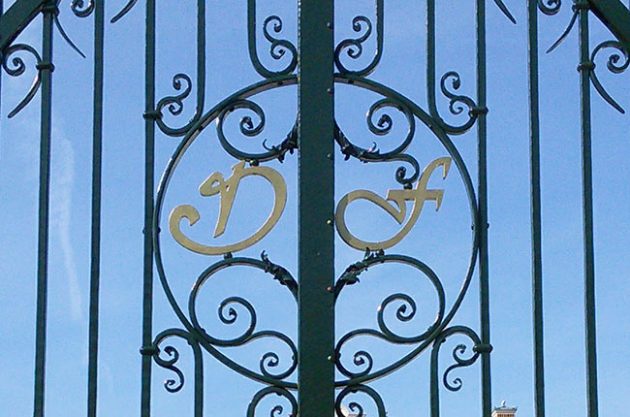Andrew Jefford gets to know a fractious Italian champion….

Jefford on Monday: The nth degree winery
Andrew Jefford is amazed by Dal Forno during a trip to Veneto.
When travelling in Veneto this spring, I visited Dal Forno. In 30 years of wine reporting, I’ve never come across a story quite like this.
Back in 1983, a grape-grower in one of the least prestigious parts of Valpolicella thought that, instead of delivering his fruit to the local co-operative, he might try to make some of his own wine. He was called Romano Dal Forno, and he was based in Illasi, well to the east of the Classico area. His father Ernesto told him it was a stupid idea; other villagers teased him for his quixotic ambitions. But he went to visit the region’s most famous winegrower, Giuseppe Quintarelli, who was kind to him and who encouraged him. He was stubborn; he persisted. His first wines reached the market in 1987.
“He’s for sure strong, very convinced of his ideas, sometimes very hard to talk with,” resumes Romano’s own third son Michele. “He was very courageous and brave to start this business in an area which wasn’t famous for quality wines. He wanted to do something different, to find a way to implement what he had in mind, but he had no background in winemaking. It wasn’t easy; he never studied. He had to learn everything by doing.”
The new Dal Forno winery, built between 2001 and 2008, is gleaming and Napa-sized, but more than that, it’s a hymn to technical innovation and perfection. You’d guess that there were at least three generations and a stack of oenology degrees behind it, not a self-taught starter from an unheralded part of a once-derided denominazione. The achievement is an awesome one.
The stainless-steel tanks, to begin with, operate using vacuum pressure. All of them, including the blending tank; the steel is a centimetre thick. Why? Because Dal Forno is obsessed in part with avoiding oxidation, which Michele calls “our main concern down the years”. A vacuum was Romano’s solution. Vacuum, remember, is space without matter (theoretically speaking) and in a practical sense it is space partially exhausted by withdrawing air by artificial means. Less air means less oxidation.
There is no use of vacuum, of course, during fermentation (though there is plenty of innovation, as I describe below). Once fermentation is over, though, the finished wines are racked into nitrogen-flushed tanks and are put under vacuum prior to barrel ageing, and after barrel-ageing for the blending process prior to bottling. Bottling itself is done by putting the empty bottle under vacuum, then flushing it with nitrogen, then putting it under vacuum once again before filling; while a nitrogen flush followed by vacuum and another nitrogen flush precede corking.
Dal Forno also invented a system of four independently operating pistons in each tank to perfect the extraction process. These are even capable of turning the entire cap upside down, the aim being “maximum extraction with maximum softness,” according to Michele. He also went on to design a moveable automated washing system for each tank which works at high temperatures and high pressure – and therefore dispenses with any chemical adjuncts, using water and steam alone.
Valpolicella, of course, is a region where the grapes are partly dried for use in Amarone. Since Dal Forno is the winery of the nth degree, though, every single grape is dried to a greater or lesser extent, including those for ‘ordinary’ Valpolicella (though there are no ordinary wines here). The Valpolicella grapes are dried for a month and a half; the Amarone grapes for three months.
The prodigiously inventive Romano Dal Forno, though, has designed his own system of moveable fans in the two huge drying chambers which work day and night to keep the air in motion. The whole system is computer controlled, with the computer able to open and shut the windows as well as move the fans and change their operating speed, and with an element of randomness built into the programming in order to mimic nature most effectively. “We have a lot of technology, but the idea behind all of it is to follow tradition most closely – dynamic tradition, if you like,” says Michele.
The cellars then descend 11 metres underground, and the barrel room (all the wines spend two years in new French barriques – and then four in bottle before release) flaunts the most beautiful vaulted brick ceiling I have ever seen: a work of art in itself. Any winery this size in South Africa or Chile would have a staff of 30, but the most extraordinary aspect of all may be the fact that only Dal Forno family members are allowed to work in this huge winery. Bottling and packing was underway on the day I called. The bottlers and packers were Michele’s two brothers Marco and Luca, his sister-in-law Linda (married to Luca) and his aunt Paola. External help is only required at harvest.
It’s not all high-tech, though. Romano Dal Forno was tending plants with a watering can in the early spring sunlight when I toured the winery. His wife Loretta arrived on a bike with a cabbage and a bunch of rosemary, in preparation for lunch. The entire family lives at the winery, and they gather for blind tastings in the evening. There are, you have to conclude, no families like Italian families.
Needless to say, there are vineyard innovations in the vineyards, too, especially with high-density plantings (up to 12,800 plants per hectare) and yield reduction strategies (severe green harvest and triage in the vineyards by the pickers). This part of Valpolicella isn’t just flatland vineyard, either. I went with Michele to see the very steep south-west-facing Seré vineyard in neighbouring Tregnano, planted in three tight varietal blocks with Corvina, Oseleta and Croatina and used for Vigna Seré (see below). The family are great believers in the importance of the tannic Oseleta and the complex sugars of Croatina; they don’t bother with Molinara, by contrast. They have no white varieties planted at present (Illasi also lies in the Soave zone) but don’t rule it out for the future.
And the wines? They aren’t to everyone’s taste: those who cherish lightness and freshness are sometimes taken aback by their size and density, and then criticise them for a lack of ‘classicism’. Perhaps, too, it’s just not politically correct (or vinously correct) in some circles to acclaim wines this masterful.
I love them. They are indeed singular — but magnificent: true nth degree wines of extraordinary consistency, with powerful and almost shattering personalities. They are generosity incarnate, but are nonetheless faithful renditions of the aromas and flavours that this unique place, with its ancient varieties and traditions, can surrender; they are pristine in style, too, and subtle in grain. Their balances, and the softness of their extractive wealth, means that they are supremely drinkable wines in the grand, large-boned style; the oak is no more excessive here than it is chez Guigal, and the alcohol seamless (even when it reaches 17%, as it does in the 2011 described Amarone below). Astonishing work, in sum, from an astonishing family.
Tasting Dal Forno

Romano Dal Forno and his wines. Image credit: Andrew Jefford.
Valpolicella Superiore, Monte Lodoletta, Dal Forno Romano 2011
This wine is a blend of 70 per cent Corvina with 20 per cent Rondinella and just 5 per cent each of Croatina and Oseleta. It’s deep black-red in colour, and is dark and forceful, sombre yet voluptuous in aroma: a harmonious weave of black chocolate, sloe and elderberry, with the years in oak bringing a cedary refinement. On the palate, it’s a vault of a wine: deep, dark and roomy, packed with earthy refinements and black-fruited echoes, both severe yet soft and enticing too. The tannins are ample yet fine-grained, the acidity delicate and sustaining. I wrote about the ‘crocodilian’ character of grand Veneto dried-fruit reds wine back in April ()
but the teeth are polished ivory here. This is horizon-altering ‘Valpolicella’ which would perform outstandingly in any Amarone tasting. 96
Amarone della Valpolicella, Monte Lodoletta, Dal Forno Romano 2011
The blend for this wine, whose fruit is dried for three months, is 55 per cent Corvina, 15 per cent Rondinella, 20 per cent Croatina and 10 per cent Oseleta; all the vines are at least 10 years old. A black wine, and a velvet nosebox: pressed black fruits, seeping with fruit essences; smoke and cinders; herbal complexities; teasing floral notes, too, to lighten the tone a little. The alcohol level on the label might lead you to expect a gobstopper – so you’ll be taken aback by the fine-milled elegance of this wine, by its disposition and organization, by its fleet-footed elegance and freshness, even though its concentration, power and textural presence make it a wine of absolute authority. There isn’t a trace of superfluous fat in the mid-palate – though it’s tongue-coating, head-turning, inspiring: a gathering of sumptuous fruited energies. “It’s very difficult to for my father to feel happy about any of his wines; he’s very critical,” said Michele. “But with this vintage, he didn’t have anything to say.” 99
Vigna Seré, Passito Rosso, Veneto IGT 2004
The family withdrew their Recioto from the DOC after the 2003 was rejected by the Consorzio tasting panel for insufficient typicity (“it was like a slap in the face to us”); after that, the wine became an IGT named after its leading vineyard. It goes to market in the best years only; 2004 is only the sixth vintage produced. Is it wine or perfume? The aromas of this dark passito (dried for four months) leave you wondering: there’s rose, lily and jasmine in here somewhere, as well as milled wheat grains and pounded dark plums. It’s almost jammy, but there’s nothing that resembles burnt sweetness so in the end you conclude that a purée is a better allusion. On the palate, there’s sweet enchantment to begin with; the black fruits just tiptoe towards fig, raisin and prune without ever quite losing freshness. Then you notice the dark tannins, waiting like masked dancers in the wings, and the warm resolving acidity, the length, and the dreamy seamless sumptuousness … and then you forget to think at all, and just surrender to its embrace. 98
More Andrew Jefford columns on Decanter.com:
Andrew Jefford recommends wines to try…
Everything you need to know about Crémant de Bourgogne…
A chat with wine teacher Michael Schuster…
